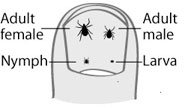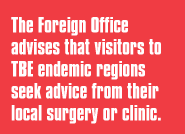FAQs
Q. What time of year am I most at risk?
Q. What are the first signs of infection?
Q. Will I know if I have been bitten by a tick?
Q. Does insect spray work against ticks?
Q. How do I remove a tick?
Q. How long do ticks remain on a person?
Q. Can I be vaccinated against tick-borne diseases?
Q. Is the level of tick disease rising?
Q. Where do ticks live?
Q. How do I spot a tick?
|
Q. What time of year am I most at risk?
Ticks are most active in the spring and summer months, between March and October.
Q. What are the first signs of infection?
There are quite a number of different infections spread by ticks; each will have different symptoms. With Lyme disease, the first symptom is often an expanding red skin rash around the site of the tick bite. There may also be headache, muscle / joint aches and fever.
In many parts of Europe and Russia tick borne encephalitis (TBE) is a problem. First symptoms of this infection are fever, tiredness, muscle aches and nausea.
Q. Will I know if I have been bitten by a tick?
Often tick bites go unnoticed as the tick anesthetises the small area of skin with its saliva.
Q. Does insect spray work against ticks?
Yes, good insect repellents will help to reduce the number of tick bites. Protective clothing can also be helpful although ticks may spend several hours wandering around looking for a good feeding spot once they have managed to find you. Treating clothing with an insecticide could be helpful.
This can be tricky as many ticks use a cement-like substance to glue their mouth parts in place while they are feeding on your blood. The best method is to get a good pair of tweezers, grip the tick as close to your skin as possible and pull it straight out. Remove ticks as soon as possible to reduce the risk of infection and take care to remove all of the mouth parts.
To reduce the risk of infected materials being injected in to you, avoid the following:
squeezing the body of the tick, application of substances such as Vaseline, nail polish etc, application of burning matches / cigarettes.
Q. How long do ticks remain on a person?
Some ticks will feed for a few hours. Others can stay on your skin, sucking blood for up to 3 weeks if they are not removed. If you are camping or walking in infected areas, check your skin regularly for ticks, at least every evening. Ticks can attach themselves almost anywhere on the body, but prefer creases like the armpit, groin and back of the knee.
Q. Can I be vaccinated against tick-borne diseases?
There is a vaccine available for tick borne encephalitis. Those camping and walking in the infected areas of Europe and Asia in the spring and summer months can get advice from their doctor or nurse or visit a travel clinic. Allow plenty of time, 2 doses at least 2 weeks apart are required to provide protection. This should be completed at least 2 weeks before going in to the risk area.
There is no vaccine for many of the other diseases transmitted by ticks. Lyme disease can be treated with antibiotics if it is diagnosed early enough.
Q. Is the level of tick disease rising?
A number of European countries have reported an increase in cases of tick borne encephalitis over recent years including Switzerland, Germany, Poland and Czech Republic. Other areas have reported a decline in the number of cases.
Ticks live in the soil and emerge to climb tall grass, shrubs, bushes and low level tree branches up to a height of 20cm-70cm in search of a blood host. They attach when people or animals brush past and look for an area of soft skin to insert their feeding organ and suck blood, which is when disease is transmitted.
(Source: www.lymediseaseaction.org.uk/)
Ticks are small, blood sucking arthropods related to spiders, mites and scorpions. There are many different species each preferring to feed on the blood of different animal or human hosts.
There are three stages in a tick’s life-cycle: larva, nymph, and adult.

To the naked eye the larvae look like specks of soot, while nymphs are slightly larger, pinhead or poppy seed size. With their eight legs, adult ticks resemble small spiders.
Lynda Bramham
Lynda is a senior nurse adviser at MASTA Ltd; she provides advice and training to doctors and nurses on travel health topics. MASTA runs a network of travel clinics throughout the UK.


